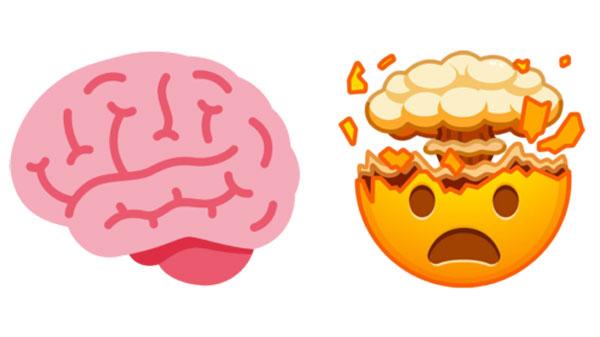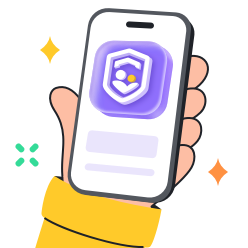Communication has greatly evolved over the years, and emojis play an important role. Among all, emojis such as the 🧠 brain emoji have become very popular, especially among teenagers. Although the emoji seems pretty straightforward to a parent as it represents ‘thinking,’ ‘intelligence’ or ‘learning.’ However, in slang, it is far more nuanced than one would expect.
That’s why cracking emoji meanings is essential, and this guide aims to explain how to interpret the different meanings of the brain emoji. We’ll also discuss when the use of brain emoji might be a concern, and how to engage your teens to communicate about appropriate online conduct. So, be with us!
What does a brain emoji mean?
The 🧠 brain emoji is mainly used when noting someone thinking, learning, or exhibiting knowledge. It is also used to remind one to think rationally, provide deeper thoughts, and just be intelligent. Now let’s see some real-life examples!
After solving a hard problem step, someone may say to you, “Wow you have a huge 🧠. ” As a way to appreciate you. Moreover, people now also use it for themselves saying, “I finally solved that puzzle, my 🧠 is working today!”
Similarly, in case a friend forgets their jacket on a very cold day. With emoji-enabled text, you may say “Come on use your 🧠 next time!”
Apart from this, you can use brain emojis after listening to exceeding facts that make you go jaw open. If ever you hear an outrageous fact like “Did you know honey never spoils?”, in response to this fact you may say “Whoa that is insane 🤯🧠.” It’s a fun way of showing being shocked.
Furthermore, when your learning is at a whole new level, this brain emoji fits you perfectly. After reading a captivating book, you can share how that book is gonna fill your brain with knowledge!
What does the Brain emoji mean in slang?
There are different slang meanings for the 🧠 brain emoji and some of them can be comical or even inappropriate one . So, let us take a look at its meaning in a bit more detail.
i. Being smart or a genius
Winning a competition or completing a difficult examination can be perceived as boosting or augmenting someone’s intelligence. So, in this case, the slang interpretation may accompany the 🧠 emoji. If your friend does well on a test, you might text them, “You got a 🧠on that exam!” Moreover, you can add a playful picture of them with a glowing brain to enhance the message.
Alternatively, a person may also do a not-so-bright thing and their friend could be sarcastically like “Wow, big 🧠 move”- meaning that that person is not very intelligent, indeed.
ii. Overthinking too much
Moreover, if you are spending a few hours bare contemplating what outfit you should put on. Consider yourself teased with “My friend, you are using your 🧠 way too much for this!”, your brain is probably a bit overloaded and underutilized at the same time so it can take a break.
iii. Inappropriate or sexual meaning
This is one area that you need to pay special attention to. You’ve probably seen that on social media some users apply the brain emoji to a sexual connotation. It could denote oral sex with the word play “giving brain.” For instance; if you see a message like:
“She really gave me that 🧠 last night.” Then it means she performed oral sex. However, this brain emoji Along with emojis like 🍆 or 💦, usually has a more explicit meaning. So, just be cautious!
Use parental controls to gain more insights on their online interactions
Is a brain emoji a sexting emoji?
Sexing or suggestive texting does involve the use of the 🧠 brain emoji at times. But here’s the catch—it doesn’t imply actual cognition in this case. Rather, it is utilized as a metaphor comprising some other meaning. You may see it in a post or message somewhere, and if you are not familiar with the meaning, it can be bewildering.



In addition, many also make use of the emoji brain to flirt or message in a cheeky manner to suggest their thinking without articulating it. It serves the purpose of avoidance to be conceivably direct. Apart from this, there are other contexts in which people used it along with other emojis like the 🍆 eggplant or 😏 smirk that together have a much deeper significance. To illustrate, let’s explore some examples!
When someone texts you, “You deserve some 🧠,” you can be assured that abstract reasoning is clearly not the topic of conversation. It is simply being used in this context for something x-rated. Equally, if someone asserts, “I bet you are marvelous in performing 🧠,” You can reasonably assume they are not discussing matters relating to academic disciplines or cognitive abilities.
Thus, in case you receive a message that contains a brain emoji and something seems off, trust your instincts. With this newfound understanding, be careful how you use the brain emoji. 🧠
How teens use brain emoji online?
Emojis tend to add a layer of fun and expressiveness to messages, and all people especially teenagers love it. In texts, social media posts, and even memes, emojis convey a lot without the need to write. Let’s examine this in detail.
i. In chats
The emoji of the brain has many meanings when it comes to texting your friends 🧠. Perhaps you used it in the sentence “Wow, you have a massive 🧠!” hyping a friend who aced a test. But you could alternatively say, “Nice job, big 🧠 move!” to mock a friend who made a silly mistake. Am sure that you encounter this type of friendly banter all the time, right? This is precisely why emojis like the brain emoji make conversations more enjoyable and lively.
ii. On social media
Seeing the brain emoji in comments and captions for TikTok, Snapchat, and even Instagram is not new 🧠. You and your friends may use it when referring to overthinking such as in “Me spending 10 minutes writing ‘okay’ 🧠💭.” The brain emoji is also part of larger social media trends.
Anything a celebrity influencer does, especially if it is funny, tends to go viral and everyone begins using it. Let’s be honest, a lot of people do not want to be left out of what is trending, and the average person gets pulled into the same wave.
iii. In memes
Moreover, you likely have come across those outrageous “expanding brain” memes where the brain physically grows with each idea that is funnier or crazier than the previous one. For instance:
- “Not studying for a test 🧠“
- “Preparing the night before 💡🧠”
- “Guessing every answer and passing with flying colors 💥🧠”
Since memes spread through peer influence, the more people use the emoji in a certain way, the more it becomes part of your everyday online language. In this way, emojis like 🧠 change meaning depending on context, and friends’ meaning as something is bound to shape that context. So, the next time you drop a 🧠 in a post, think about how you and your peers grew to understand and use emojis.
When should parents be concerned about Emoji use?
The 🧠 brain emoji is often harmless. But kids can easily misuse it and use it in contexts completely unrelated to learning or thinking. Undoubtedly, the emoji culture has set in and one needs to switch their attention as to how kids use emojis, as it could point toward ill intentions.
If parents see notable shifts in how their children use emojis, then it is their lookout to ensure that everything is alright. To identify whether something is wrong, the following pointers can help.
i. Messages seem secretive
Closely monitor if your child quickly hides the screen when you walk in the room or they refuse to let you see their messages. If so, then there is a chance that inappropriate emojis are being used and they do not want parents to find out about it. Keep in mind that secrecy indeed is important, but going into extreme confidentiality could mean that they do engage in inappropriate conversations.
ii. Strange or repetitive Emoji use
Consider the possibility where an emoji as a brain 🧠 is used in a context devoid of relevant themes. This along with other emojis can certainly give out certain signals. If you observe that there is active participation in it’s use in some chats, it may be worth delving deeper.
iii. Frequent message deleting
Moreover, children often delete messages to free up some space, but if they seem to be deleting conversations on a frequent basis, it might be because something is wrong. Things get even worse if those children seem unsettled when you inquire about their chats.
iv. Changes in behavior
In case a child seems anxious or overly withdrawn and moody for no reason, then chances are that their online interactions are having an impact. Moreover, if they appear to be too bound to their phone or strongly react when you mention their use of emojis, it might be time for a discussion.
How to guide your kids about emoji usage
Children have ways of expressing themselves creatively and as unique as creating emojis. However, emojis can mean something different from what appears to be on the surface. Children of a young age may go as far as using them without fully comprehending what the emoji conveys or the implications that come with it. Moreover, peer pressure plays a huge role in what a child may deem acceptable. This is exactly the reason why it becomes essential to guide them into wise emoji usage.
i. Talk openly about emojis
Begin and encourage dialogue that is stress-free and open. Try to understand what they think certain emojis stand for and how they may use them in literally any way. Moreover, keep in mind that some emoji’s meanings change with the context. So, you must be the friend of your kids, so kids may openly talk about their online activities like what kind of emoji they are using and which ones are in trend!
ii. Set clear digital boundaries
Try to set time-optimal rules. Something such as, “If you ever encounter messages containing emojis that bother you, feel free to speak up”. Add on to this by teaching them to keep in mind that many are not appropriate for your age.
iii. Use parental controls for extra safety
Children can still stumble upon dangerous content even after having open conversations with their parents. In that aspect, FlashGet Kids is something worth considering. It helps supervise conversations and online activities in a manner that maintains their confidentiality. With this kind of technology, you can assist them when necessary while not overstepping boundaries.



Thus, engaging actively in setting rules, having the right conversations, and using the correct technology gives you the ability to guide your child to navigate the online world securely.

